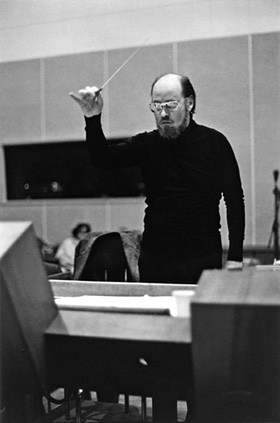The summer of 1975 remains etched in cinematic history, largely thanks to a film that dared audiences to go back into the water. Jaws, directed by Steven Spielberg, wasn’t just a box office phenomenon; it was a cultural reset, and at its heart, or perhaps its menacing pulse, was the unforgettable Theme Song From Jaws. Composed by the legendary John Williams, this simple yet terrifying motif became synonymous with suspense, fear, and the primal dread of the unknown lurking beneath the surface.
Rarely has such a minimalist piece of music achieved such a profound impact. The theme song from Jaws, primarily utilizing just two notes, E and F, played in a repetitive, accelerating crescendo, is a masterclass in building tension. It’s a sound that, even decades later, instantly conjures images of a great white shark relentlessly hunting its prey. Steven Spielberg himself acknowledged the power of Williams’ score, stating it made the movie “more adventurous and gripping than I ever thought possible.” This wasn’t just background music; it was an integral character in the narrative, amplifying the fear factor to unprecedented levels.
 John Williams passionately conducting the score for Jaws, highlighting his crucial role in the film's terrifying atmosphere.
John Williams passionately conducting the score for Jaws, highlighting his crucial role in the film's terrifying atmosphere.
The Genesis of a Theme: Williams and Spielberg’s Collaboration
The collaboration between Spielberg and Williams began a year prior with The Sugarland Express, but it was Jaws that solidified their iconic partnership. Williams recounted his initial experience with the film in a screening at Universal Studios, recalling being “so excited” by the potential of the project. He recognized Jaws as an opportunity for music to play a pivotal role, not just in underscoring the suspense but also in adding layers of adventure and even subtle humor to the narrative.
When it came to crafting the theme song from Jaws, Williams focused on simplicity and primal impact. He described his concept to Spielberg as a “sea chase” with moments of “swashbuckling” orchestral energy. However, the core, the very essence of the shark, was to be found in a motif that was “simple, insistent and driving, that it seems unstoppable.” This led him to the now-famous two-note ostinato, a rhythmic foundation built from the lowest registers of the orchestra – basses, celli, trombones, and tuba.
Initially, Spielberg was skeptical. Williams humorously recalled playing the simple E-F-E-F bass line on the piano and Spielberg’s initial laughter. Yet, Williams persisted, explaining how this basic motif could be orchestrated and developed to create a powerful and menacing presence. Spielberg, trusting Williams’ vision, gave the now-iconic response: “Let’s try it.” This pivotal decision unleashed one of the most recognizable and effective theme songs in movie history.
Simplicity and Power: Deconstructing the Shark Theme
The genius of the theme song from Jaws lies in its stark simplicity. Using just two notes, Williams creates a sense of relentless dread. The minor key and the descending interval contribute to the feeling of unease and impending danger. The rhythm, initially slow and deliberate, gradually accelerates, mirroring the shark’s approach and building unbearable suspense.
The instrumentation is equally crucial. Williams employs the deep, resonant tones of the lower brass and string sections to give the theme a visceral, almost physical weight. It’s not just something you hear; it’s something you feel in your chest, a primal warning signal. This sonic depth perfectly complements the unseen terror of the shark, heightening the audience’s imagination and fear of what lurks beneath the waves. The theme’s flexibility is another key to its success. It can be played softly to suggest the shark’s lurking presence, or at full orchestral force to accompany a full-blown attack, always maintaining its menacing character.
Beyond the Theme: The Broader Score of Jaws
While the theme song from Jaws is undoubtedly the most famous element, the complete score showcases Williams’ versatility and mastery. He crafted a musically diverse landscape that went far beyond just the shark motif. For the bustling Fourth of July beach scenes, Williams composed a lively promenade, ironically titled “Tourists on the Menu,” providing a stark contrast to the lurking danger. He created an eerie and unsettling soundscape for Quint’s chilling monologue about the USS Indianapolis, and a complex, Bach-inspired “shark cage fugue” for Hooper’s underwater encounter.
The score also features moments of adventure and even levity. A hornpipe accompanies the Orca’s departure, and Korngold-esque brass fanfares underscore the boat chase, injecting a swashbuckling energy into the pursuit. This range of musical styles demonstrates Williams’ ability to serve the narrative on multiple levels, enhancing not just the horror but also the adventure and human drama of Jaws.
Impact and Legacy: The Jaws Theme in Pop Culture
Jaws was a cultural phenomenon, and its theme song became instantly iconic. The film’s success propelled John Williams to the forefront of film composers, earning him his second Academy Award, along with a Golden Globe, Grammy, and BAFTA award. The theme song from Jaws, alongside his Star Wars score, is credited with revitalizing the symphonic film score and paving the way for a new era of blockbuster movie music.
The impact of the theme song from Jaws extends far beyond the film itself. It has permeated popular culture, becoming a shorthand for danger, suspense, and sharks in general. It’s been parodied, referenced, and sampled countless times in various media, cementing its place as one of the most recognizable and influential pieces of music ever written for film. Spielberg’s assertion that the score was “clearly responsible for half of the success of that movie” is not an exaggeration. The theme song from Jaws is more than just music; it’s a cultural touchstone, a sonic embodiment of fear that continues to resonate with audiences worldwide.
